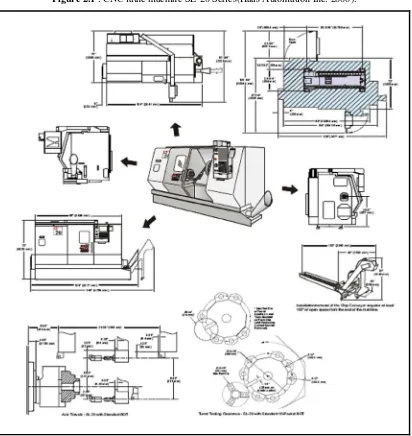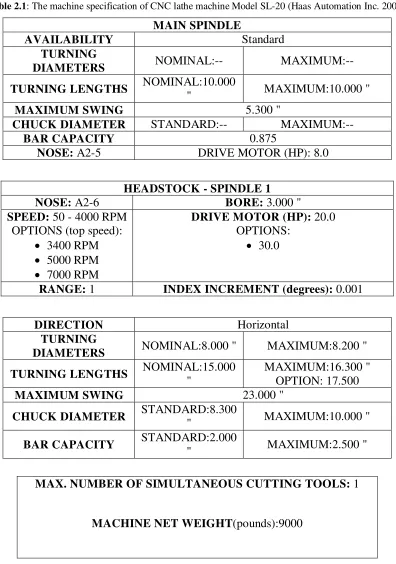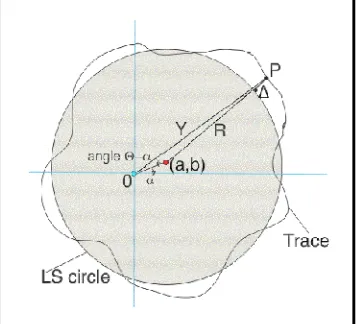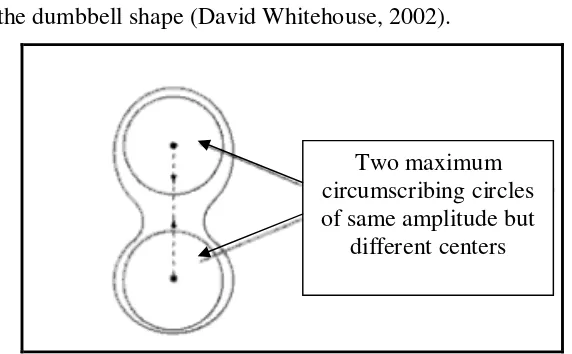UNIVERSITI TEKNIKAL MALAYSIA MELAKA
AN EXPERIMENT STUDY OF THE EFFECT OF CUTTING
SPEED, DEPTH OF CUT AND FEED RATE TO ROUNDNESS IN
CNC LATHE
This report submitted in accordance with requirement of the Universiti Teknikal Malaysia Melaka (UTeM) for the Bachelor Degree of Manufacturing Engineering
(Manufacturing Process) with Honours.
by
MOHD HAFIZ BIN ISMAIL
i
ABSTRACT
This project entitled “An Experiment Study of The Effect of Cutting Speed, Depth of cut and Feed rate to roundness in CNC lathe” is contain about the effect of parameter on roundness and to get the best parameter setting for the CNC lathe machine in term of roundness. This project objective to investigate the contribution of the feed rate, cutting speed and depth of cut in CNC lathe machine at FKP machine shop laboratory by conducting several machining process and then analyzed the roundness of the finish product using CNC Roundness tester machine.
The overall effectiveness of this project needs methodology to collect the data, calculating the data and analyze the data. The collecting data is at all samples after the machining operation. After get the result, the data will test using CNC Roundness tester machine using least Square Circle Method. Then, the result will analyze using Design of Experiment (DOE) to get the contribution of parameter in roundness.
ii
DEDICATION
iii
ACKNOWLEDGEMENT
First and foremost, I would like to express my highest appreciation to my supportive supervisor, Mr Amri bin Sulaiman for his supervision and support in completing this thesis.
Next I would like to dedicate my thankfulness and acknowledge to laboratory technicians, who has been so warmth and kind to provide sincere assistance and good cooperation during the training period. Their cooperation is much appreciated. . In addition, I would like to convey thanks to Miss Liew Pay Jun for her assistance, which really spends her time to teach me a lot of knowledge regarding to the DOE.
iv
2.1.2 Machine specification 7
2.1.3 Fundamental of CNC lathe cutting (Graham T.smith, 2002) 8
2.2 Roundness 8
2.2.1 Roundness measurement 9
2.2.1.1 Method in Measure Roundness 9
2.2.1.2 Least Square Method 11
2.3 Cutting Parameter 12
2.3.1 Feed Rate 12
v
2.3.2.1 Effect of Work Speed on Geometrical Characteristic 14
2.3.3 Depth of Cut 16
2.4 Material 16
2.4.1 Aluminum 16
2.4.1.1 Aluminum characteristic 17
2.4.2 Aluminum 6061 18
2.4.2.1 Chemical Composition for Aluminum 6061 18
2.4.2.2 Mechanical Properties 19
2.5 Design of Experiment (DOE) 19
2.5.1 DOE overview 19
2.5.2 Factorial design 20
2.5.3 Implementation of factorial design 21
2.6 Mahr Formtester MMQ44 (Mahr GmbH, 2007) 22
CHAPTER 3 24
METHODOLOGY 24
3.1 Flow Chart 25
3.2 Material 27
3.2.1 Material Selection 27
3.3 Machining Setup Parameters 27
3.3.1 Parameter Setup by Applying Two Level Factorial Method 27
3.3.2 Data Table 28
3.3.3 Methodology for DOE 29
3.4 CNC Lathe Machine Set-up 30
3.4.1 Specimens Preparation 30
3.4.2 Parameter Setting 31
3.4.3 Machining Procedure 31
3.4.4 Methodology of Machining Operation Using the CNC lathe machine 32
3.5 Analysis 32
3.5.1 Methodology of Roundness Measurement 32
vi
3.6 Data Analysis 34
3.6.1 Design of Experiment (DOE) 35
3.7 Gantt Chart Of The Study For PSM 1 36
3.8 Gantt Chart Of The Study For PSM 2 37
CHAPTER 4 38
RESULT AND ANALYSIS 39
4.1 Result of roundness of Aluminum 6061 40
CHAPTER 5 45
DISCUSSION 45
5.1 Roundness Numerical result analysis 47
5.2 Roundness graphical result analysis 48
5.3 Finding from the result 50
CHAPTER 6 51
CONCLUSION 51
6.1 Conclusion 51
6.2 Recommendation 52
REFERENCES 53
vii
LIST OF TABLE
2.1 The machine specification of CNC lathe machine Model SL-20 7
2.2 Cutting speed for various material 15
2.3 Mechanical properties for aluminum 6061 18
2.4 Example of 2k factorial design 22
3.1 The arrangement of the high and low using full Factorial design 28 3.2 The arrangement of the high and low value using full Factorial design 28
3.3 DOE matrix 35
3.4 Gantt chart of the study for Projek Sarjana Muda 1 (PSM 1) 36
3.5 Gantt chart of Projek Sarjana Muda 2 (PSM 2) 37
4.1 Roundness result for sample A 39
4.2 Roundness result for sample B 39
4.3 Optimum parameter effect 40
viii
LIST OF FIGURE
2.1 CNC lathe machine SL-20 Series 6
2.2 View for CNC lathe machine SL-20 series 6
2.3 The diagram shows the trace and Y, the distance from the spindle
center to the trace at the angle 9
2.4 Problem with plug gauge method 10
2.5 The least square circles diagram on roundness material 12 2.6 The cutting forces reduce with the increasing of cutting speed 16 2.7 Schematic diagram of the main feature of just one configuration
for roundness testing machine 23
3.1 The flow chart of the project 26
3.2 Provided Aluminum 6061 Dimension 27
3.3 Plan for DOE 30
3.4 The flow chart of machining methodology 32
3.5 The CNC Roundness – Formtester MMQ44 manufactured by Mahr at
the Metrology Laboratory 33
3.6 Work piece been placed on chuck and probe been place near the
work piece surface 34
4.1 Pareto chart of the effect for sample A 40
4.2 The Pareto Chart of the Effects for sample B 40 4.3 The Normal Probability Plot of the Effects for sample B 41 4.4 The Normal Probability Plot of the Effects for sample B 41 4.5 The Main Effects Plot (data means) for sample A 42 4.6 The Main Effects Plot (data means) for sample B 42 4.7 The Interaction Plot (data means) for sample A 43 4.8 The Interaction Plot (data means) for sample B 43
ix
4.10 The cube plot (data means) for sample B 45
5.1 Roundness average against number of experiment 47
5.2 Sample main effect plot for sample B 49
5.3 Sample interaction plot for sample B 49
1
CHAPTER 1
INTRODUCTION
2
1.1 OBJECTIVE
I. To investigate the contribution of feed rate, cutting speed and depth of cut in CNC lathe machine.
II. To analyzed the roundness of the finish product using CNC Roundness tester machine
III. To find the best parameter for aluminum 6061 and determine the relationship between the parameter and the roundness using Design of Experiment (DOE) IV. To identify the parameter that effect the most in roundness
1.2 SCOPE
3
1.3 PROBLEM STATEMENT
Roundness is one of geometrical tolerance that needs to be maintain when machining cylindrical part. To obtain good tolerance of roundness three controllable parameter need to be controlled. The parameters are depth of cut, speed (rpm) and feed rate that is setup by the operator in the program. However, the value of parameters depends on the size of the work piece to be machined. These controllable parameters are usually adjusted to get the fine quality of roundness.
Before this there are no appropriate parameters when cutting the aluminum 6061 in term of roundness. Hence, this study will develop the appropriate parameter for the CNC lathe machine model SL-20 for this material.
This experiment also tries to get which parameter that affects the most in cutting aluminum 6061. There is previous research that related to this study and therefore on this experiment try to verify those research.
4
CHAPTER 2
LITERATURE REVIEW
5
2.1 CNC lathe machine
2.1.1 CNC Lathe Machine Model Haas SL-20
For this PSM project will use CNC lathe model SL-20 series from Haas Automation that available in FKP laboratory. CNC lathes are designed to meet the needs of modern machine shops, now and long into the future. The SL Series offers a wide range of capacities, and our space-saving Big Bore option increases capacity further while retaining the original footprint. The SL-20, with a max turning capacity of 10.3" x 20" and an 8.3" chuck, has a bar capacity of up to 2.0".
SL- 20 high-performance turning centers also feature massive headstock castings with symmetric ribs for rigidity and thermal stability; on-the-fly wyes-delta switching for peak performance throughout the rpm range; and embedded chip trays and high-volume coolant systems for efficient chip removal. For control features advanced tool management, single-button features, 15-inch color LCD monitor and a USB port. With this feature it raised CNC turning to new levels of reliability, ease and productivity.
6
Figure 2.1 : CNC lathe machine SL-20 Series(Haas Automation Inc. 2008).
7 2.1.2 Machine specification
Table 2.1: The machine specification of CNC lathe machine Model SL-20 (Haas Automation Inc. 2008).
MAIN SPINDLE
DIAMETERS NOMINAL:8.000 " MAXIMUM:8.200 " TURNING LENGTHS NOMINAL:15.000
MAX. NUMBER OF SIMULTANEOUS CUTTING TOOLS: 1
8
2.1.3 Fundamental of CNC lathe cutting (Graham T.smith, 2002)
There are two main factors influence a cutting process, which are independent variables and dependent variables. The dependent variables that are influences by changes in the independent variables such as:
Force and energy dissipated in the cutting process.
Temperature rise in the workpiece, the chip, and the tool.
Wear and failure of the tool.
Surface finish produced on the workpiece after machining.
The major independent variables in the cutting process are follows:
Tool material, coating, and tool condition.
Tool shape, surface finish, sharpness.
Work pieces material, condition, and temperature.
Cutting parameter such as speed, feed rate, and depth of cut.
Cutting fluid.
The characteristic of machine tool, such as its stiffness and damping.
Work holding and fixtures.
2.2 Roundness
9
speed increase and feed decreases, loss of precision in roundness tends to increase (Engineering statistic handbook, 2007)
2.2.1 Roundness measurement
The measurement of roundness can be made by two ways. The first way is to use Coordinate measuring machine (CMM) and the second one is using MAHr Roundness Tester Machine. Using roundness tester machine the machine will compare the roundness from the product with actual sample roundness result. Three measurement of roundness were taken at different location.
2.2.1.1 Method in Measure Roundness
Measurements of roundness require 360° traces of the workpiece made with a turntable-type instrument or a stylus-turntable-type instrument. A least squares fit of points on the trace to a circle define the parameters of noncircularity of the workpiece. A diagram of the measurement method is shown below (Engineering statistic handbook, 2007).
10
They are four reference circles are internationally accepted for roundness measurements. They are:
i. Maximum radius inscribing circle (MIC);[6] The MIC is the largest circle just contained by the profile of a work piece. It is also known as the plug gauge circle and is intended for shafts (Guru S.M and Tsai D.M, 1998).
A circle is drawn within all the data and is expanded until it is constrained by three valleys (David Whitehouse, 2002).
The center obtains by this method need not to be unique (David Whitehouse, 2002).
For this method there is ambiguity if there are two equally good centers like in the dumbbell shape (David Whitehouse, 2002).
Figure 2.4: Problem with plug gauge method (Engineering statistic handbook, 2007)
ii. Minimum radius circumscribing circle (MCC) (Guru S.M and Tsai D.M, 1998).
The MCC is the smallest circle that just contains the profile of a work piece. It is also known as the ring gauge circle and is intended for holes (Guru S.M and Tsai D.M, 1998).
A circle is drawn around all the data and then shrunk onto to the data to get the minimum size circle (David Whitehouse, 2002).



